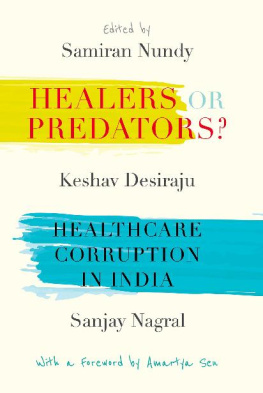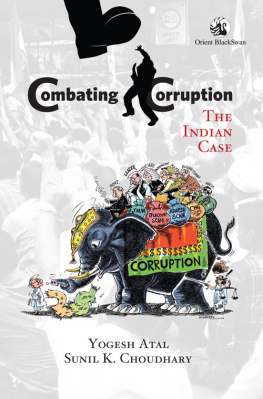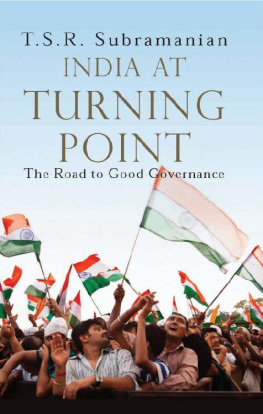HEALERS OR PREDATORS?
HEALERS OR PREDATORS?
Healthcare Corruption in India
edited by
Samiran Nundy
Keshav Desiraju
Sanjay Nagral
Oxford University Press is a department of the University of Oxford.
It furthers the Universitys objective of excellence in research, scholarship,
and education by publishing worldwide. Oxford is a registered trademark of
Oxford University Press in the UK and in certain other countries.
Published in India by
Oxford University Press
2/11 Ground Floor, Ansari Road, Daryaganj, New Delhi 110 002, India
Oxford University Press 2018
The moral rights of the authors have been asserted.
First Edition published in 2018
All rights reserved. No part of this publication may be reproduced, stored in
a retrieval system, or transmitted, in any form or by any means, without the
prior permission in writing of Oxford University Press, or as expressly permitted
by law, by licence, or under terms agreed with the appropriate reprographics
rights organization. Enquiries concerning reproduction outside the scope of the
above should be sent to the Rights Department, Oxford University Press, at the
address above.
You must not circulate this work in any other form
and you must impose this same condition on any acquirer.
ISBN-13 (print edition): 978-0-19-948954-1
ISBN-10 (print edition): 0-19-948954-8
ISBN-13 (eBook): 978-0-19-909577-3
ISBN-10 (eBook): 0-19-909577-9
Typeset in Bembo Std 11/14
by The Graphics Solution, New Delhi 110 092
Printed in India by Gopsons Papers Ltd., Noida 201301
Contents
Ritu Priya and Prachinkumar Ghodajkar
Shiv Visvanathan
Kaveri Gill
Amit Sengupta
Sunil K. Pandya
Avinash Supe and Soumendra Sahoo
M.K. Mani
Sumit Ray
Vinay Kumaran
S.V. Nadkarni
S. Srinivasan
Yogesh Jain
Kavita Narayan
Rema Nagarajan
Sanjay A. Pai
M.S. Valiathan
V.I. Mathan
Abhijit Chowdhury
George Thomas
Arghya Sengupta and Dhvani Mehta
David Berger
Md Khairul Islam, Shehlina Ahmed, and Shishir Moral
Harendra de Silva
Shershah Syed
Meeta and Rajivlochan
Sunil Nandraj
Surajit Nundy
Abhay Shukla
Rakhal Gaitonde
Kunal Saha
Farokh Erach Udwadia
Ratna Magotra
Rupa Chinai
Sandhya Srinivasan
Lakshmi Narasimhan, Nisha Vinayak, Kishore Kumar, and Vandana Gopikumar
Sunil Chandy
G.D. Ravindran
S.P. Kalantri and Anshu
Binayak Sen
Amrita Patel
M.R. Rajagopal
Despite being one of the fastest growing economies in the world, India ranks among the poorest achievers of good health. The shortfall of Indias health achievements compared with those of, say, China or Thailand (in terms of expanding longevity, reducing infant and maternal mortality, curbing child undernourishment, eliminating health-cost-induced indigence, and other indicators) is large and has been growing larger. Even within South Asia, Bangladesh and Nepal have overtaken India in health accomplishment, including in life expectancy.
If Indias bad record in healthcare is not much discussed in the Indian press, this neglect does not indicate the presence of a tolerable level of healthcare in India, but reflects instead the narrow reach of the Indian news media, with its traditional neglect of elementary education and healthcare. That neglect is, in fact, a contributory factor to the continuation of Indias health failure and bad schooling for the population at large, since public discussion is one of the essential requirements for remedying policy failures. Public discussion is particularly important for policy making in a functioning democracy, and it is remarkable that in the public discussion preceding political elections (such as the Indian general elections of 2014), healthcare tends to get extraordinary little attention.
In this collection of well-researched essays on the state of healthcare in India, the editors (Samiran Nundy, Keshav Desiraju, and Sanjay Nagral) have offered us a timely opportunity to understand how badly things have gone wrong in our beloved country. They have also offered illuminating analyses of the causes and remedies of the observed failures.
What explains Indias healthcare debacle? One immediate account is readily available, but we must be careful not to see more explanation there than a deeper scrutiny can confirm. India spends a much lower proportion of its national income on healthcare than do many other nations with comparable achievements in economic development. Seen on its own, this line of explanation is certainly important. The fact that India allocates only a little over 1 per cent of its gross domestic product on public healthcare contrasts sharply, for example, with nearly three times as much by China. We reap as we sow, and cannot expect to get what other countries achieve by allocating much more resourcesas a proportion of their respective levels of the gross national productto healthcare.
There is clearly some truth in seeing Indias healthcare failure in this perspective, but the story is much bigger than that. The low allocation of public resources to healthcare is merely one of the relevant factors, and important as it is as an account of what ails Indias healthcare, the neglect of resource commitment probably hides as much as it reveals. As the studies included in this important collection bring out, Indias healthcare failure is far more extensive than the resource story alone can capture.
The entire organization of Indian healthcare has become deeply flawed in nearly every respect. The story that emerges from these carefully researched studies is that of a comprehensive healthcare crisis. The editors go further than that, and see in these failures a picture of healthcare corruption, which is a more disparaging diagnosis. Corruption is a charge that must not be made lightly. But, alas, these studies bring out why this disheartening depiction is basically correct. In the many-sided failures of Indian healthcare arrangements, the cupidity and greed of the agents involvedat different levelsplay a distressingly important role.
There is, to start with, the reflection of a pervasive failure in the widely observed fact that the poor find it difficult, if not impossible, to make use even of those services that are actually available, or can be easily mobilized. Private caregivers will not budge without the promise of payment, and even though some public services are offered freely, many critically important services are denied unless the patient is willingand ableto offer the demanded sums, which can be unaffordably large for the underprivileged Indians.
There are many other failures to which these studies draw attention. Medicine is often hard to get, and spurious drugs are too readily churned out by manufacturers and distributers. That story of culpability frequently extends to medical equipment and implements.
Regulations to restrain pilferage and enforce accountability are recognized as important (as they should be), but are often successfully circumvented, yielding a financial bonanza for the violators. Laws governing clinical establishments, which exist in theory, remain quite largely unimplemented.












